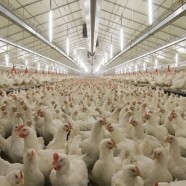The Benefits Of Poultry LED Lighting
Chickens raised using an intelligent poultry LED lighting system have been found to produce higher quantity and quality of eggs, develop into maturity at a faster rate and enjoy an improved standard of health as compared to chickens raised under traditional light sources.
Using LED-based technology chicken farmers can:
- Lower lighting costs
- Increase musculoskeletal development and weight gain
- Induce earlier maturity for hens destined to lay eggs
- Increase egg output and quality
- Regulate reproduction cycles
- Increase length of reproductive life
Furthermore, farmers can adjust the color of the LED lights to promote certain outcomes. For example, using red light, farmers were able to stimulate sexual activity and reduce the amount of feed necessary to produce each egg — even though there was no difference in the size, or quality of the egg. The red LED lights were able to increase egg production by up to 38 per hen while decreasing food consumption by 20 percent.
Green lights promotes chicken growth at early stages of development, while blue light promotes growth later along the life cycle of the chicken.
Blue and green light improved feed conversion (the efficiency at which an animal converts animal feed into desired output such as eggs or meat) by up to 4%, and therefore reduced cost per pound of the chicken by up to 3%.
Why is Poultry LED Lighting Superior to Traditional Poultry Lighting?
Visible “white” light is actually composed of a range of colors, which can be viewed by refracting light through a dispersive prism.
Incandescents, the most common form of poultry barn lighting, are missing many critical portions of the full spectrum found in sunlight. For instance, an incandescent bulb produces a highly diminished amount of both greens and blues.
CFLs produce only narrow bands of color in the red, green and blue spectrums. These narrow bands mean that a large amount of the rich color wavelengths found in sunlight are lost.
The following chart shows the color distribution of incandescents (top) and CFLs (bottom).
Compare these charts to the following chart that shows the color spectrum of sunlight. Notice how weak the color distribution is in these traditional sources as compared to sunlight.
Now compare these charts to the chart below that shows the spectrum of colors found in LED lights. While not as rich in color as natural sunlight, LED lights clearly do a far better job of replicating an even distribution of colors than incandescents or CFLs.
LEDs Cutting Costs in the Barn
Dr. Joey Bray of Steven F. Austin University computed the energy use of LEDs versus existing incandescents and HPS lighting systems in a common midwestern poultry production setting. His study found that the average chicken farm using incandescents and HPS consumed 3,837 kWh per flock per year.
The same “average” farm equipped with LEDs consumed just 109 kWh for the same flock per year, representing a savings of 95%.
The combined high reliability and low maintenance costs of LEDs means that even with the higher initial costs, the low energy and maintenance costs end up offering an excellent ROI for agricultural businesses.
Poultry LED lighting in Kenya
In developing countries, high energy costs are often a major constraint to economic development. Countries such as Kenya are seeing rising demand for chicken products but increasing cost of energy inputs has dampened the industry’s growth.
In this environment, the industry’s dependency on inefficient, polluting kerosene fuels for lighting has been called into question. Researchers from the International Finance Corporation and the Lawrence Berkeley National Laboratory conducting a field study on chicken house lighting and found that solar portable LED lighting is a very effective alternative to kerosene.
The study looked at three identical poultry houses: one lit under kerosene, one lit using a solar-wind fluorescent system, and one using a solar potable LED lighting system.
LED lighting was found to produce approximately twice the illumination of fluorescent and kerosene options while only using half the energy input. Furthermore, the LED-lit rooms had a more even distribution of lighting.
While the Kenyan chicken farmers’ net income increased by 15% using both the LED- and fluorescent-lit chicken houses in comparison to the kerosene-lit house, the drastically lower costs of the solar LED system meant that the LEDs paid for themselves in just 1.5 years. In comparison, the solar-wind fluorescent system took 9.3 years to cover the initial investment.
In addition to the ongoing cost savings, switching to LEDs avoids over one metric ton of annual carbon dioxide emissions compared to kerosene.














